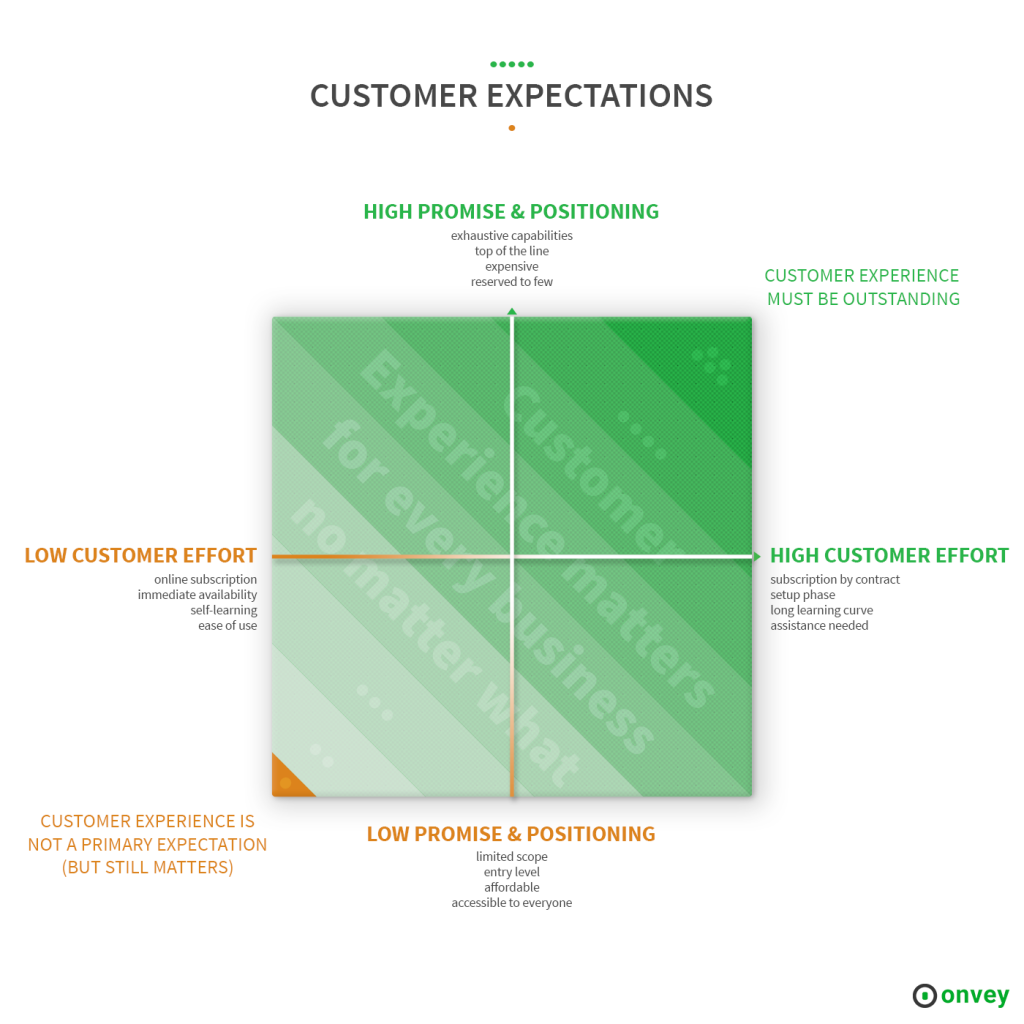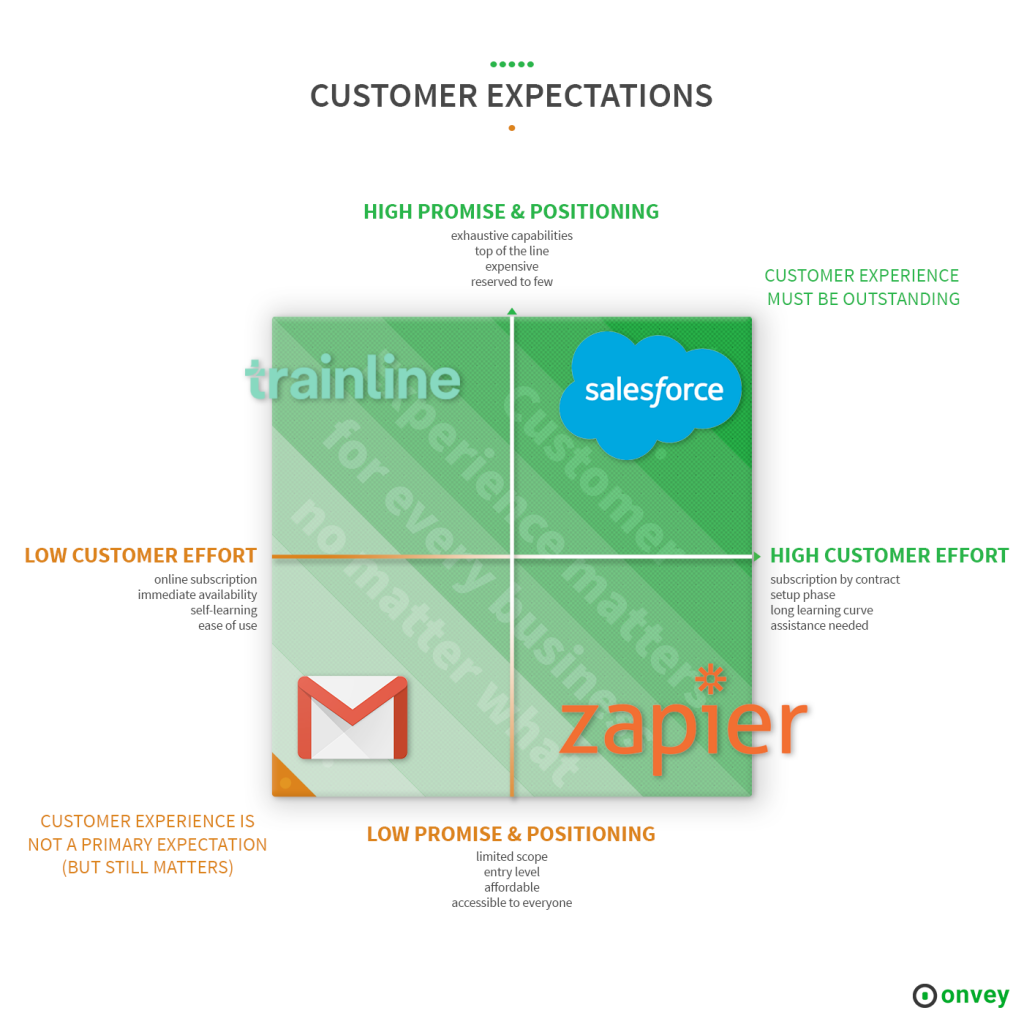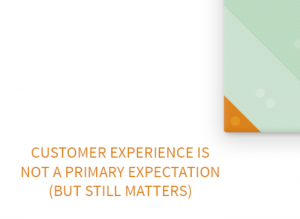We cannot do everything ourselves. We perform the tasks for which we are appreciated and we appreciate. We delegate the rest to others. Especially, but not only, if it involves:
- Repetitive, recurring and time consuming jobs like house cleaning;
- Specific skills, like medical knowledge or simpler knowing how to make clothes;
- Atmosphere and elegance, like entertaining in a restaurant.
We choose not to perform the tasks above ourselves. Instead, we exchange a little of our wealth with someone who can feel appreciated for them and who appreciates doing them.
And we have expectations in return.
This existential principle applies in full to online business, SaaS , and e-commerce.
Why Customer Experience matters in online business
Customer Experience has a paramount importance in any online business. It matters even more if the answer to some or all of these questions is yes:
- Is a service being offered (does someone pay to receive service)?
- Do potential customers have choice between service providers?
- Does revenue depend on the customer satisfaction?
Success in any competitive landscape involves paying extensive attention to Customer Experience and on attempting to deliver more than customers expect at all times.
It does not matter if one is selling a single product, a hundred products, or even ‘just a service’. Today, even car repairers have to make customers happy. Offering that little extra would induce them to come back. Perhaps that ‘little extra’ is something simple like getting their cars cleaned, getting their oil changed, or lending them a courtesy car if theirs has to stay in the garage for, say, longer than half a day.
To ask when one should care about Customer Experience is actually to adopt an erroneous perspective towards the issue. Customer Experience should be the first thing one addresses when launching any business.
Let us attempt, however, to tackle the issue in an alternative manner. Let us try to identify cases in which one would be allowed not to care (well, not to care all that much) about Customer Experience.
How much does Customer Experience matter in a set business
If you still need more proof that Customer Experience matters in business, do the following exercise:
Understand why people (should) come to your business.
What is the value it offers them? What is the main reason they select your service rather than another?
When promoting your online service, you would naturally highlight its advantages over competitors who offer pretty much the same. This, alongside the formulation of the promise, is pretty much what marketing people call the value proposition, i.e. the promised value the business will deliver, and the expression of the reason intended to convince a potential customer to become an actual customer.
The value proposition has to be convincing and fair. It musts reflect what your business is genuinely able to deliver in order to generate satisfaction among its hard-won customers.
An important point to note at this juncture is that the higher the value promise sets the bar, the higher customers’ expectations will be. Judging the precise level ought to be central to the business thinking at all times, and it ought to be challenged continuously.
Understand what people expect from your service.
People’s expectations of service mostly depend on:
- The value proposition: the promise and its positioning in the competitive landscape
- The effort involved in accessing and obtaining a service (or product)

The higher a promise is set, the higher expectations will be. The same applies to the effort access takes: if access is difficult, as with rare and distinguished marques, expectations will be very high – and the opposite.
An everyday example of this would be a McDonald’s restaurant versus a Michelin three star establishment. Though the two are competitors only in the broadest sense (their promise is obviously very different), one is likely to be available at the next corner, while the other will insist on a reservation made with a fortnight’s notice – and a Uber to cover the distance. The amount of effort is different.
Now, how does this relate to IT/software/online businesses?
Software and online service case examples
High promise, high customer effort: Salesforce
This is the ultimate customer relationship management solution. Capable of everything, it is the first name that comes to your mind when one thinks CRM (apologies to its competitors!). It is also probably one of the most expensive, and difficult to deploy across any organisation, larger or smaller. In return, expectations are very high: far higher than those involved even in choosing one set of software over another. At the very least, users expect gains in productivity and return on investment ratios.
To satisfy their customers, Salesforce has to offer a massively variegated amenity facilitating integration of their service, training users, and easing their daily duties.
High promise, low customer effort: Trainline
This company has one simple, yet very strict promise: to make your next train ticket booking easier than ever. The price is the same, but the experience is easier and more pleasant. Since this is pretty much a nice-to-have rather than a must-have promise, customer expectations are moderate.
The company targets dynamic people who travel a lot. The medium of their product presentation (extremely smooth, dynamic, and rapid) is very much the message itself. This is their way of offering satisfaction, given the often extreme complexity and frustration often engendered by more traditional train ticket platforms.
(I should point out that here I am referring specifically to trainline.fr. This used to be capitainetrain.com and was acquired in 2016 by trainline.com. I used this service a lot, but have never actually used trainline.com ‘in anger.’)
Low promise, high customer effort: Zapier
It starts free, and keeps the simple promise of interconnecting your apps and automating workflows, but non-savvy people would not be able to use it all that easily. Expectations are moderate, at least at first, though tenacious newcomers would quickly be thrilled by the capabilities of the service.
To reach a high level of satisfaction, Zapier must keep in mind the relative difficulty of using their service. This means it has to provide a high class support service to help users attain the promise.
Anyone who has talked to the Zapper support team would agree that they understand this very well.
Low promise, low customer effort: Gmail
It is free, extremely simple to adopt and use. It also comes with a lot of additional features of which users might not be aware of and which they might not use, but which it is good to know exist just in case. In addition, it makes potential users aware of itself through dozens of channels, including a large range of devices.
Since Gmail is a generic email for ‘the huddled masses’ everywhere, user expectations are quite low. Basically, Google has to deliver what little is written on the tin.
In this case, a plain shrug of the shoulders and the phrase “well, it works” is sufficient satisfaction.
Where is the Customer Experience in all this?
The examples show that delivering positive Customer Experience correlates broadly with value promise, market positioning, and customer effort involved in using one service rather than another.

Gmail ends up in the bottom left corner. Yet, few would say that Gmail offers poor experience. It simply does the job customers expect of it, and can do far more if they can be bothered to find out about all the options. In addition, it is never down. On top of that, few have ever had reasons to contact Gmail support. Google have not forgotten to consider Customer Experience. They have nailed it by lowering users’ expectations to a minimum while delivering an ever more complete suite of tools covering all basic and some not so basic needs.
Readers can rest assured that Gmail and each of the companies outlined above have addressed the issue of Customer Experience carefully. Intriguingly, each has adopted different solutions:
- Salesforce: a customer tailored service;
- Trainline: an outstandingly fluid navigation;
- Zapier: accessible and responsive customer support;
- Gmail: a minimal but exhaustive, practically eternally reliable service.
Delivering great Customer Experience will be a completely different mission from service to service, interface to interface, industry to industry.
Less is More
In delivering more than customers expect, service providers can struggle to match customer expectations, or else relax and lower these expectations.
Now that we are aware of how important Customer Experience is, we face the question of how it can be achieved.
The usual answer involves more of whatever matters in an industry. More service, a more fancy service, more tools, more usability… But in the light of the above examples, a heretical thought ought to have sneaked its way in “Less is More“.
Lowering customer expectations
Customer expectations correlate highly with the value promise. This in turn means the value promise should correlate highly with actual delivery.
It further follows that an easy way to improve Customer Experience is simply to reduce the scope a value promise. Doing so has the twofold result of reducing customer expectations and allowing service providers to match them more easily.
A few days ago, we re-posted this in our UX curation on Twitter :
Many teams create a product that solves a problem well. And they just keep adding more to it. And more. And more. Until it becomes so complicated and bloated the people who were happy to begin with start looking for something that returns to the basics.
@NateKontny : Are you making your customers too happy?
Lowering customer expectations by reducing the value promise is obviously best done at the planning stage, before things are in flux. Yet, it is never too late to revamp a value proposition, reshape a website, or even do a complete U-turn by pivoting. Above all, every further product move should result from cogitation about its potential impact on expectations: does it bring something additional; what new expectations might flood in if this door is opened; can the organisation match rise to them?
Reducing customer effort should lead initiatives to optimise experience
The marketplace offers a myriad ways specifically intended to optimise user experience. They promise to make products more pleasant, more engaging, and more efficient. A/B testing, analytics, live chats all come to mind.
Instead of being dazzled by the “more” arsenal on offer, however, one should simply focus on asking users to expend less effort when receiving a service.
This can take place at every floor of the customer relationship:
- The discovery phase and the attendant effort to find a service: how to get on prospects’ radars, gain credibility, and lead them to a website;
- The onboarding phase and the attendant effort in adopting a service: how to facilitate subscription, accompany customer onboarding, facilitate acceptance and use of a service across teams and companies;
- The usage phase and the attendant effort to maintain a service: how to ease everyday use and ensure that customers never have a reason to seek another service.
UX optimisation is a team process that must occur at every step of a service’s creation and lifespan. And the important thing to remember is that adding more service to an offer creates more expectations from users.
So when is Customer Experience not a priority?
The chances of any service ending in the category that can afford not to care about Customer Experience are very slight.

Even though a service’s promise might be very low, and even though that service might be incredibly easy to find, adopt, and maintain, does not mean that service can forget to consider Customer Experience.
Trying to establish the list of conditions that would allow a service not to consider experience is enlightening. They would be:
- Services based on a basic right: justice (litigants, not customers!), public healthcare (patients, not customers!), education (scholars and students, not customers!) when they are paid by the community;
- Non profit services or advocacy: these are not revenue raisers and their ‘customers’ are not seeking a good experience, but supporting a bigger common cause.
It ultimately distills to the sole case of servicing people who are not really customers. All these services share the characteristic to be largely accessible, and have a low promise – relatively to other similar services that would ask you to pay for it.
(Please note that services which are free at the point of delivery are not necessarily non profit services. Gmail is free, but is certainly not non profit!)
To recapitulate, you can afford not to care about Customer Experience when you do not deal with customers! Any activity involving customers calls for a Customer Experience mindset.
Final quiz
Choose the mindset which best describes that of your company:
- Our company will do everything for its customers.
- Our company wants its customers to be happy in order to retain them over time.
- Our company keeps it simple. In resolving a problem, it resolves it for good.
Which of the above do you think might be licensed not to care about the Customer Experience it delivers?
.
…
………
………………
…………………………
………………………………………
………………………………………………………
………………………………………………………………………
……………………………………………………………………………………………
…………………………………………………………………………………………………………………
………………………………………………………………………………………………………………………………
Answer: None of them, of course!

Gotcha.
In a nutshell, not caring about Customer Experience is okay only if you do not want to make money from customers. If you found the correct answer, you are allowed to join our UX newsletter for more articles like this one! 😉

 Why Startups Should Not Seek Media Buzz At Any Cost
Why Startups Should Not Seek Media Buzz At Any Cost Psychology of Choice applied to Web & App Design: Convince Clients!
Psychology of Choice applied to Web & App Design: Convince Clients! Brands: Joining Battle For Customers’ Hearts, Not Just Pockets
Brands: Joining Battle For Customers’ Hearts, Not Just Pockets